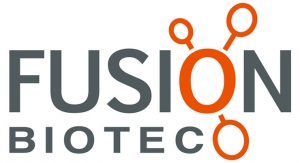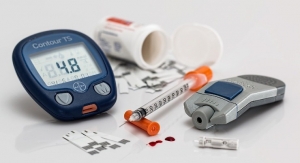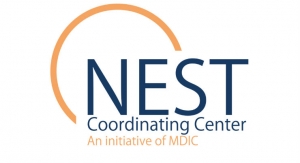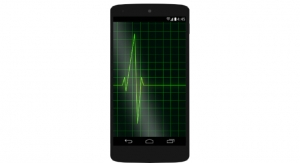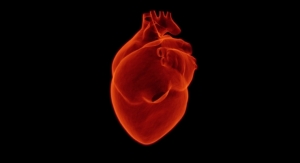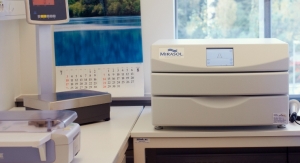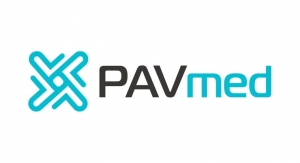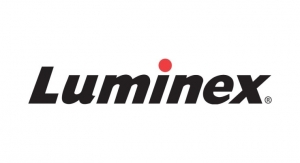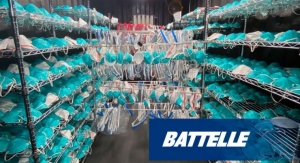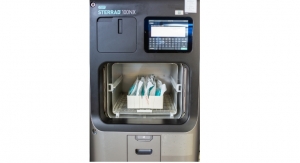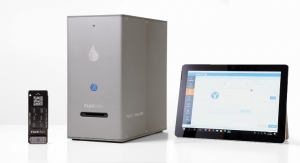Michael Barbella, Managing Editor01.30.19
Glory be to CORA, and the frighteningly fantastical future of medicine.
CORA is an early warning system for impending cardiac episodes. Slightly larger than a postage stamp, she can accurately predict forthcoming heart-related events (infarctions, congestive heart failure, etc.), and recommend a specific treatment regimen to patients. CORA knows when its user should rest, take a pill, or seek immediate medical attention. She can even call for an ambulance, if necessary.
Sound too good to be true?
Sadly, it is. CORA is pure fiction, an idea conjured directly from the imagination of legendary writer, inventor, and visionary Arthur C. Clarke. CORA was part of Clarke’s classic 1979 novel “The Fountains of Paradise,” an award-winning tale of one man’s quest to link Earth to the stars via a space elevator (somewhat like a “cosmic sling”). At one point in the story, the hero protagonist, Dr. Vannevar Morgan—the elevator’s structural engineer—seeks treatment from his physician for shortness of breath.
After first chiding Morgan for ignoring his symptoms, the physician prescribes treatment with CORA. “...there’s no great harm done—if you follow instructions from now on. Mine, and CORA’s,” states the physician, William Sen.
“CORA’s?” Morgan asks.
“Coronary alarm.”
“Oh—one of those things.”
“Yes—one of those things,” Sen barks. “They save about ten million lives a year. Mostly top civil servants, senior administrators, distinguished scientists, leading engineers, and similar nitwits. I often wonder if it’s worth the trouble. Nature may be trying to tell us something and we’re not listening.”
After recommending the non-implantable CORA model for Morgan (worn under the breastbone), Sen demonstrates the tiny device’s diagnostic acumen. “The doctor threw one of the numerous switches on his desk console, and a sweet mezzo-soprano voice remarked in a conversational tone: ‘I think you should sit down and rest for about ten minutes.’ After a brief pause, it continued: ‘It would be a good idea to lie down for half an hour.’ Another pause. “As soon as convenient, make an appointment with Dr. Smith.’ Then:
“Please take one of the red pills immediately.”
“I have just called the ambulance. Just lie down and relax. Everything will be all right.”
“Morgan almost clapped his hands over his ears to cut out the piercing whistle.
“THIS IS A CORA EMERGENCY! WILL ANYONE WITHIN RANGE OF MY VOICE PLEASE COME IMMEDIATELY!. THIS IS A CORA EMERGENCY! WILL—”
“I think you get the general idea,” said the doctor, restoring silence to his office. “Of course, the programs and responses are individually tailored to the subject. And there’s a wide range of voices, including some quite famous ones.”
Acclaimed vocalizations aside, CORA truly is a revolutionary invention, mainly for its mind-boggling prognostic and analytical prowess. Perhaps more importantly, however, the device further validates Clarke’s legacy as a visionary genius, as CORA has manifested itself (an entire century early, no less) in Boston Scientific Corp.’s HeartLogic Heart Failure Diagnostic.
Like CORA, HeartLogic is designed to predict worsening heart failure and potentially stave off cardiac arrest. Unlike its fictional counterpart, though, HeartLogic is only available in implantable form.
Approved by the U.S. Food and Drug Administration (FDA) for conditional use in an MRI environment, the HeartLogic product aims to prevent hospitalizations by proactively warning cardiac patients of impending heart failure. The system features standard implantable cardioverter defibrillator (ICD) hardware, including electric leads, a pulse generator, and a titanium-enclosed accelerometer; using leads attached to the right atrium, right ventricle and left ventricle, the battery-powered device sends stabilizing electrical signals to better coordinate the heart’s contractions.
“Right now what we do for patients with heart failure is when they leave the clinic, we rely on them to call us about their symptoms,” noted Adrian Hernandez, M.D., FMHS, vice dean of clinical research at Duke University School of Medicine. “What we’d like to do is actually understand when they have worsening problems before they have symptoms because then we can act on it.”
HeartLogic achieves such a goal through a proprietary algorithm that uses sensor data to evaluate cardiac sounds, thoracic impedance, respiration rate and volume, heart rate, and activity over time. The tool uses detected impedance between the HeartLogic lead and pulse generator to determine the impact hemodynamics and lung conditions have on breathing rates, thoracic impedance, heart rate, and activity.
The HeartLogic algorithm automatically calculates a daily heart failure index, unique to each patient, that is monitored over time and can proactively alert doctors to a subject’s declining health. A 900-patient, one-year clinical study found the diagnostic expanded upon the ability of baseline blood tests to help identify patients at high risk of heart failure, and the combination of the HeartLogic with a baseline NT-proBNP accurately identified patients with risk groups at 23 to 50 times increased risk for such events. Previous published data on the HeartLogic system have reported a 70 percent sensitivity and the ability to provide an average 34 days advanced notice and low burden for detecting deteriorating heart conditions.
“It’s a pre-emptive strike. If we can change the course so they have a smoother course, fewer symptoms, fewer hospitalizations, that’s much better for the patient and it’s much better for our healthcare system,” stated John Boehmer, M.D., principal study investigator; director of the Heart Failure Program at Penn State Health Milton S. Hershey Medical Center; and professor of medicine at Penn State College of Medicine.
“The highlights from the MultiSENSE study are two-fold,” he continued. “One, is we were able to develop an index that had both good sensitivity and very good specificity for predicting heart failure. That’s very exciting, that was the primary goal. But what has me even more excited is the long lead time—from the time an alert occurs until the heart failure event. The median time is 34 days. That gives us a great opportunity to change the course of the future.”
And the course of healthcare. Devices like HeartLogic are becoming more prevalent nowadays as medtech companies re-evaluate their research and development (R&D) approaches amid the shift toward value-based medicine. This transition is requiring firms to focus on innovation that serves unmet clinical needs, reduces costs, and optimizes care delivery.
Some of the new technologies being developed under the value-based system are falling outside the traditional medtech sphere. In a departure from their core competencies, many companies are incorporating sensors and software into their devices and diagnostics to generate, gather, and transmit or share data.
Medtronic plc’s Guardian Sensor 3, for example, is the only glucose sensor to receive FDA approval for controlling automated insulin delivery through a hybrid closed-loop system (the MiniMed 670G, a.k.a., “artificial pancreas”). The sensor is 80 percent smaller (in volume) than the company’s Enlite model, and features a diagnostic chip that automatically monitors the sensor’s health every five minutes for maximum performance and minimal variability. It also is the company’s most accurate sensor, with an 8.7 percent mean absolute relative deviation.
Sensors also are figuring prominently in Johnson & Johnson’s R&D pipeline: The 133-year-old multinational firm is exploring the idea of implanting sensors into artificial joints like knees and hips to monitor patients’ range of motion during physical therapy.
“There’s a trend to develop more smart devices, and the inclusion of sensors and data transmission from devices is certainly becoming more prevalent in today’s market,” remarked Jim Kelley, senior director, R&D, Cardio & Vascular, at Integer, a Plano, Texas-based medical device outsource manufacturer. “Using data to better manage patients’ chronic diseases is important.”
Cost is important too, though its significance has magnified in recent years with the shift to value-based care. Pricing pressures and changing purchasing dynamics are compressing medtech companies’ margins and spawning the development of service-oriented solutions that help payers and providers reduce overall healthcare costs.
Royal Philips has been on the forefront of these solutions for more than 15 years with its near real-time remote patient monitoring and early intervention program (eICU) that already has saved healthcare providers millions of dollars. Company statistics show the program saves an average $5,000 per patient and $1.2 million from reduced transfers; studies also indicate eICU has reduced costs from intensive care unit (ICU)-related medical malpractice claims by 90 percent (from $6 million to $500,000), and expedited patient discharges by 20 percent.
Philips’eICU program enables physicians to remotely monitor critically ill patients at multiple sites from a centralized support center. Using telehealth equipment, the doctors also can conduct video consultations with bedside caregivers to discuss treatment plans.
Over the course of its lifetime, Philips’ eICU program has become just as valuable to patients as it is to the health ecosystem: The telehealth tool has been found to improve overall ICU survival rates by 26 percent and hospital discharge rates by 15 percent. More importantly, however, eICU provides doctors with predictive insights into potential health hurdles for critically ill patients, allowing for earlier intervention.
Numerous other medtech OEMs have followed Philips’ lead in offering cost-saving solutions to payers and providers, including Baxter International Inc., Medtronic, Stryker Corp., and Zimmer Biomet Holdings Inc.
Baxter’s value-based care effort is similar to Philips’—its Sharesource telehealth platform enables clinicians to remotely monitor and adjust patients’ dialysis treatments (ideally preventing any potential issues due to missed sessions).
Stryker Corp. and Zimmer Biomet Holdings Inc., meanwhile, are helping hospitals manage bundled payments for joint replacements. The pair’s two programs (JointCOACH and Signature Solutions, respectively) support better patient care for Medicare-eligible hip and knee procedures through an array of value-enhancing services like pre-operative planning, patient engagement, pain control, rehabilitation, and data analytics.
Medtronic took the bundled payments approach one step further by partnering with UnitedHealthcare in 2016 to give the insurer’s diabetic members access to advanced insulin pump technologies and support services. Thus far, the union seems to be paying off, helping to reduce preventable hospital admissions 27 percent in the first year, according to Medtronic and UnitedHealthcare data.
“Value-based healthcare is about improving patient care and doing it at a lower cost. There are several ways to achieve this through R&D,” explained Keith Seitz, senior director, R&D, for Cardio Rhythm Management & Neuromodulation at Integer. “One approach is to focus on cost-cutting initiatives to reduce the total cost of a medical device. Another approach is to invest in R&D innovation that enables lower total healthcare costs. For instance, leadless pacing can be less expensive than a traditional pacemaker, and that reduces overall patient risk and ultimately brings cost savings to the healthcare system. Or Sub-Q ICDs that remain ‘outside the heart’ can reduce the risks for patients prone to infection. This also has a benefit of lowering total healthcare costs.”
Self-Reliant No More
Tradition be damned.
Medtech R&D is no longer the private, highly secretive, core competency-focused architect of such blockbusters as the cardiac pacemaker, aluminum splints, sterile sutures, and oscillating saw. That breed of research and development began fading into oblivion around the turn of the millennium.
In its place is a more social, open-minded model willing to partner or purchase its way to product differentiation. Inspired (more likely forced) by the shift to value-based care, companies are now more willing than ever to seek other ways to innovate.
Acquisitions have become a popular product development strategy, as it quickly and easily gives device firms access to desired technologies outside their core competencies. Medtronic has employed this tactic countless times throughout its history, most recently with last year’s $1.64 billion purchase of Israeli-based Mazor Robotics Ltd., maker of robotic surgical systems for brain and spine procedures.
“The healthcare industry is in the middle of a major shift. It’s become easier to know a solution when you see it (through acquisition) rather than to predict it (through internal marketing and R&D),” noted Steve Maylish, chief commercial officer of Fusion Biotec Inc., a contract design and product development firm headquartered in Orange, Calif. “In many cases, the technology acquired is not part of the acquirer’s expertise or core competence, so the make vs. buy decision is less complicated. If technology is moving fast, and medical companies don’t have the bandwidth or expertise to develop the desired product(s) internally, then why not fill the gap or expand the portfolio through an acquisition? It is much easier to see something and say, ‘That’s what we need as a company,’ as opposed to predicting the direction of the market.”
It’s also easier to acquire a technology born in a startup, which generally lacks the financial resources and personnel to fully develop revolutionary innovation.
“Most game-changing innovations are coming from smaller startups,” said Raghu Vadlamudi, chief research and technology director for Donatelle, a medical device contract manufacturer based in New Brighton, Minn. “Large OEMs are investing in these startups, often with an option to acquire once the developing product receives FDA approval. This process allows for faster development of the product.”
A speedier development process is now fairly certain for Cephea Valve Technologies Inc.’s latest invention—a minimally invasive mitral valve treatment device—thanks to new ownership. The Silicon Valley firm was purchased in mid-January by longtime financier and healthcare behemoth Abbott Laboratories, which first staked its claim in the smaller company in July 2015.
Cephea is developing mitral valve treatment technology that eliminates the need for risky open-heart surgery (its device is deliverable through a leg vein). The newly-acquired innovation joins other mitral valve-focused devices previously purchased by Abbott, including the MitraClip technology it acquired from Evalve in 2009 and minimally invasive mitral valve systems from Tendyne Holdings, which it obtained from its original Cephea investment.
Past choices have proven fruitful for Boston Scientific as well: The company last year purchased the remaining stakes in two startups it had previously backed, instantly enhancing both its electrophysiology and atrial fibrillation ablation procedure portfolios.
The $40 million buyout of Securus Medical Group provided Boston Scientific with an FDA-approved thermal body mapping device for use in cardiac ablation procedures, while its $202 million purchase of Cryterion Medical gives the lar- ger OEM possession of potentially cutting-edge technology. Cryterion’s experimental catheter device uses extreme cold to perform a cardiac ablation; the system is designed to improve maneuverability and positioning within the heart’s anatomy.
“Companies are thinking beyond their traditional core competencies,” Integer’s Kelley told Medical Product Outsourcing. “Business models are being challenged. Are there new revenue streams? If so, how do we capitalize on them? It’s forcing R&D [teams] to think more broadly about identifying the customer and associated requirements.”
This expanded customer scope, consequently, is begetting some interesting R&D bedfellows. Although medtech companies continue to rely on core internal research, they also are increasingly partnering with non-healthcare organizations to access the digital skill sets necessary for innovation.
Many of these alliances are being formed to provide healthcare firms with expertise in data analytics, data management, software development, and more recently, virtual reality and artificial intelligence (AI).
Medtronic, for instance, is collaborating with University of Dundee (Scotland) students to design augmented reality apps for medical education and training using the Microsoft HoloLens. Similarly, GE Healthcare is working with GPU inventor NVIDIA to bring AI technology to its 500,000 imaging devices worldwide. The technology is designed to accelerate blood flow reconstruction and visualization, and improve two-dimensional and four-dimensional imaging for certain solutions. The AI tool also aims to enable deep learning algorithm applications for analytics, which is integrated into clinical and operational workflows and equipment.
Medtronic and Johnson & Johnson are both delving into the AI realm as well—the former hooked up with “Jeopardy!”-winning supercomputer IBM Watson to develop a diabetes management app, while the latter is teaming with machine-learning software developer WinterLight Labs Inc. to create a speech-based system for predicting dementia and other neurological disorders.
Announced in early January, the JNJ-WinterLabs collaboration leverages the Canadian startup’s speech-based AI platform to analyze linguistic data from ongoing clinical trials for Alzheimer’s Disease treatment. The collaboration will initially focus on developing a sensitive digital biomarker that can distinguish patients with mild cognitive impairment—an early stage of Alzheimer’s Disease—from healthy elderly subjects.
“The importance and level of outside R&D collaboration required by a startup or OEM depends on the depth of knowledge and skill set of its employees, as well as the technology available to them,” Vadlamudi asserted.
Those same variables impact outsourcing partnerships too. Companies with limited technical expertise and/or staff typically lack the internal resources to develop products in a timely, cost-effective manner. Seeking outside help in R&D can reduce time to market and ensure quality innovation.
It also gives device firms access to advanced technologies. Manufacturers without knowledge of piezoelectricity or ingestible computer chips, for example, have little choice but to contract out R&D services.
“With all that’s going on in healthcare, it’s impossible to be an expert in all the different technologies, like interoperability, connectivity, machine learning, artificial intelligence, software-as-a-service [model], remote patient monitoring, MEMS, etc.,” Fusion Biotec’s Maylish said. “You can’t expect the internal R&D team to be up on all the new technology, it’s just changing too quickly. And much of the technology is a necessity.
Today there’s a push to save money and provide value in healthcare. but it’s difficult to provide that value by iterating existing designs. Looking for outside expertise makes so much more sense now, because there is so much more technology.”
All that technology, however, is driving up product development and manufacturing costs, further inducing outsourced partnerships. Specialty R&D shops not only provide medtech companies with technological know-how, they also help improve processes that otherwise can delay in-house product design or development.
Perhaps most importantly, outsourced R&D can significantly reduce costs by minimizing product risk, expediting time to market, improving organizational resources, and restructuring a company’s use of resources. The outsourcing team itself also can be less expensive than hiring a group of full-time experts in-house.
“Medical R&D providers are now more sophisticated than ever before, and tare typically driven by seasoned ‘alpha’ personality technologies who have become disenchanted with the inefficiency and bureaucracy of the corporate structure,” noted Philip Remedios, principal, director of Design & Development at Dunedin, Fla.-based BlackHagen Design, an interdisciplinary user research and product design firm. “While most consultants cannot provide the bandwidth required to gestate, develop, and commercialize every aspect of a complex medical device, many can advance the quality and innovation of the design in much less time, and often less overall cost that if that same effort was retained by the corporate team. Cross-pollination of ideas, materials, processes, and design execution is another benefit of contracting an independent team that will design a dozen different devices a year. Outsourcing has become even more attractive in an era where employees are less loyal and the cost of employment benefits skyrocket.”
Outsourcing can be particularly valuable to startups, which may lack the funding and therefore the expertise to develop innovative products from ideation to commercialization via a full time, permanent development team. Consequently, their R&D process may progress sporadically, in fits and starts, as finances ebb and flow, and/or prototype testing is conducted.
Such a choppy product development process is giving rise to “fractional” contract work; especially in leadership roles—i.e., companies and individuals that provide targeted assistance to startups at specific points within a device’s evolution process. Rather that engaging an experienced full time resource in, say, product development planning, the client company can retain that resource for the planning portion and then release them when the planning portion is complete. Likewise, if a client company is not familiar with managing external resources, a fractional project manager could help avoid confusion and missteps.
“It’s not a new idea but there seems to be a growing awareness that it can be a good use of investment money and, at the same time, reduce the risk to a new company,” explained David C. Robson, principal of Robson Advisors LLC, a Providence, R.I.-based firm offering product development advice, guidance, and advocacy to early-stage medical device clients. Robson’s firm is gaining an increasing amount of “fractional” work from customers who recognize that the cost of a fractional resource can substantially improve schedule while reducing potential for common mistakes.
“R&D goes in stages, where you don’t necessarily have all-day, everyday work. Using fractional leadership or engineering resources really depends on where the project stands in the development cycle and how much money you have to spend,” he continued. “It’s always nice to have full time, committed resources for leadership and team roles, but this may be prohibitively expensive for an early stage company. Fractional employees can be used at any point in time along that process—they can work full-time for a while, or only occasionally, depending on the company’s needs at the time. As the company succeeds in reaching funding milestones, it can transition those fractional workers into permanent positions or move to find others to fill those roles. It really doesn’t matter what the work is. There is value to having full-time resources in some critical roles, but depending on the project, those roles can change. A fractional system gives startups a way to survive. The benefits seem to work for everybody.”
Whether they’re working or not.
CORA is an early warning system for impending cardiac episodes. Slightly larger than a postage stamp, she can accurately predict forthcoming heart-related events (infarctions, congestive heart failure, etc.), and recommend a specific treatment regimen to patients. CORA knows when its user should rest, take a pill, or seek immediate medical attention. She can even call for an ambulance, if necessary.
Sound too good to be true?
Sadly, it is. CORA is pure fiction, an idea conjured directly from the imagination of legendary writer, inventor, and visionary Arthur C. Clarke. CORA was part of Clarke’s classic 1979 novel “The Fountains of Paradise,” an award-winning tale of one man’s quest to link Earth to the stars via a space elevator (somewhat like a “cosmic sling”). At one point in the story, the hero protagonist, Dr. Vannevar Morgan—the elevator’s structural engineer—seeks treatment from his physician for shortness of breath.
After first chiding Morgan for ignoring his symptoms, the physician prescribes treatment with CORA. “...there’s no great harm done—if you follow instructions from now on. Mine, and CORA’s,” states the physician, William Sen.
“CORA’s?” Morgan asks.
“Coronary alarm.”
“Oh—one of those things.”
“Yes—one of those things,” Sen barks. “They save about ten million lives a year. Mostly top civil servants, senior administrators, distinguished scientists, leading engineers, and similar nitwits. I often wonder if it’s worth the trouble. Nature may be trying to tell us something and we’re not listening.”
After recommending the non-implantable CORA model for Morgan (worn under the breastbone), Sen demonstrates the tiny device’s diagnostic acumen. “The doctor threw one of the numerous switches on his desk console, and a sweet mezzo-soprano voice remarked in a conversational tone: ‘I think you should sit down and rest for about ten minutes.’ After a brief pause, it continued: ‘It would be a good idea to lie down for half an hour.’ Another pause. “As soon as convenient, make an appointment with Dr. Smith.’ Then:
“Please take one of the red pills immediately.”
“I have just called the ambulance. Just lie down and relax. Everything will be all right.”
“Morgan almost clapped his hands over his ears to cut out the piercing whistle.
“THIS IS A CORA EMERGENCY! WILL ANYONE WITHIN RANGE OF MY VOICE PLEASE COME IMMEDIATELY!. THIS IS A CORA EMERGENCY! WILL—”
“I think you get the general idea,” said the doctor, restoring silence to his office. “Of course, the programs and responses are individually tailored to the subject. And there’s a wide range of voices, including some quite famous ones.”
Acclaimed vocalizations aside, CORA truly is a revolutionary invention, mainly for its mind-boggling prognostic and analytical prowess. Perhaps more importantly, however, the device further validates Clarke’s legacy as a visionary genius, as CORA has manifested itself (an entire century early, no less) in Boston Scientific Corp.’s HeartLogic Heart Failure Diagnostic.
Like CORA, HeartLogic is designed to predict worsening heart failure and potentially stave off cardiac arrest. Unlike its fictional counterpart, though, HeartLogic is only available in implantable form.
Approved by the U.S. Food and Drug Administration (FDA) for conditional use in an MRI environment, the HeartLogic product aims to prevent hospitalizations by proactively warning cardiac patients of impending heart failure. The system features standard implantable cardioverter defibrillator (ICD) hardware, including electric leads, a pulse generator, and a titanium-enclosed accelerometer; using leads attached to the right atrium, right ventricle and left ventricle, the battery-powered device sends stabilizing electrical signals to better coordinate the heart’s contractions.
“Right now what we do for patients with heart failure is when they leave the clinic, we rely on them to call us about their symptoms,” noted Adrian Hernandez, M.D., FMHS, vice dean of clinical research at Duke University School of Medicine. “What we’d like to do is actually understand when they have worsening problems before they have symptoms because then we can act on it.”
HeartLogic achieves such a goal through a proprietary algorithm that uses sensor data to evaluate cardiac sounds, thoracic impedance, respiration rate and volume, heart rate, and activity over time. The tool uses detected impedance between the HeartLogic lead and pulse generator to determine the impact hemodynamics and lung conditions have on breathing rates, thoracic impedance, heart rate, and activity.
The HeartLogic algorithm automatically calculates a daily heart failure index, unique to each patient, that is monitored over time and can proactively alert doctors to a subject’s declining health. A 900-patient, one-year clinical study found the diagnostic expanded upon the ability of baseline blood tests to help identify patients at high risk of heart failure, and the combination of the HeartLogic with a baseline NT-proBNP accurately identified patients with risk groups at 23 to 50 times increased risk for such events. Previous published data on the HeartLogic system have reported a 70 percent sensitivity and the ability to provide an average 34 days advanced notice and low burden for detecting deteriorating heart conditions.
“It’s a pre-emptive strike. If we can change the course so they have a smoother course, fewer symptoms, fewer hospitalizations, that’s much better for the patient and it’s much better for our healthcare system,” stated John Boehmer, M.D., principal study investigator; director of the Heart Failure Program at Penn State Health Milton S. Hershey Medical Center; and professor of medicine at Penn State College of Medicine.
“The highlights from the MultiSENSE study are two-fold,” he continued. “One, is we were able to develop an index that had both good sensitivity and very good specificity for predicting heart failure. That’s very exciting, that was the primary goal. But what has me even more excited is the long lead time—from the time an alert occurs until the heart failure event. The median time is 34 days. That gives us a great opportunity to change the course of the future.”
And the course of healthcare. Devices like HeartLogic are becoming more prevalent nowadays as medtech companies re-evaluate their research and development (R&D) approaches amid the shift toward value-based medicine. This transition is requiring firms to focus on innovation that serves unmet clinical needs, reduces costs, and optimizes care delivery.
Some of the new technologies being developed under the value-based system are falling outside the traditional medtech sphere. In a departure from their core competencies, many companies are incorporating sensors and software into their devices and diagnostics to generate, gather, and transmit or share data.
Medtronic plc’s Guardian Sensor 3, for example, is the only glucose sensor to receive FDA approval for controlling automated insulin delivery through a hybrid closed-loop system (the MiniMed 670G, a.k.a., “artificial pancreas”). The sensor is 80 percent smaller (in volume) than the company’s Enlite model, and features a diagnostic chip that automatically monitors the sensor’s health every five minutes for maximum performance and minimal variability. It also is the company’s most accurate sensor, with an 8.7 percent mean absolute relative deviation.
Sensors also are figuring prominently in Johnson & Johnson’s R&D pipeline: The 133-year-old multinational firm is exploring the idea of implanting sensors into artificial joints like knees and hips to monitor patients’ range of motion during physical therapy.
“There’s a trend to develop more smart devices, and the inclusion of sensors and data transmission from devices is certainly becoming more prevalent in today’s market,” remarked Jim Kelley, senior director, R&D, Cardio & Vascular, at Integer, a Plano, Texas-based medical device outsource manufacturer. “Using data to better manage patients’ chronic diseases is important.”
Cost is important too, though its significance has magnified in recent years with the shift to value-based care. Pricing pressures and changing purchasing dynamics are compressing medtech companies’ margins and spawning the development of service-oriented solutions that help payers and providers reduce overall healthcare costs.
Royal Philips has been on the forefront of these solutions for more than 15 years with its near real-time remote patient monitoring and early intervention program (eICU) that already has saved healthcare providers millions of dollars. Company statistics show the program saves an average $5,000 per patient and $1.2 million from reduced transfers; studies also indicate eICU has reduced costs from intensive care unit (ICU)-related medical malpractice claims by 90 percent (from $6 million to $500,000), and expedited patient discharges by 20 percent.
Philips’eICU program enables physicians to remotely monitor critically ill patients at multiple sites from a centralized support center. Using telehealth equipment, the doctors also can conduct video consultations with bedside caregivers to discuss treatment plans.
Over the course of its lifetime, Philips’ eICU program has become just as valuable to patients as it is to the health ecosystem: The telehealth tool has been found to improve overall ICU survival rates by 26 percent and hospital discharge rates by 15 percent. More importantly, however, eICU provides doctors with predictive insights into potential health hurdles for critically ill patients, allowing for earlier intervention.
Numerous other medtech OEMs have followed Philips’ lead in offering cost-saving solutions to payers and providers, including Baxter International Inc., Medtronic, Stryker Corp., and Zimmer Biomet Holdings Inc.
Baxter’s value-based care effort is similar to Philips’—its Sharesource telehealth platform enables clinicians to remotely monitor and adjust patients’ dialysis treatments (ideally preventing any potential issues due to missed sessions).
Stryker Corp. and Zimmer Biomet Holdings Inc., meanwhile, are helping hospitals manage bundled payments for joint replacements. The pair’s two programs (JointCOACH and Signature Solutions, respectively) support better patient care for Medicare-eligible hip and knee procedures through an array of value-enhancing services like pre-operative planning, patient engagement, pain control, rehabilitation, and data analytics.
Medtronic took the bundled payments approach one step further by partnering with UnitedHealthcare in 2016 to give the insurer’s diabetic members access to advanced insulin pump technologies and support services. Thus far, the union seems to be paying off, helping to reduce preventable hospital admissions 27 percent in the first year, according to Medtronic and UnitedHealthcare data.
“Value-based healthcare is about improving patient care and doing it at a lower cost. There are several ways to achieve this through R&D,” explained Keith Seitz, senior director, R&D, for Cardio Rhythm Management & Neuromodulation at Integer. “One approach is to focus on cost-cutting initiatives to reduce the total cost of a medical device. Another approach is to invest in R&D innovation that enables lower total healthcare costs. For instance, leadless pacing can be less expensive than a traditional pacemaker, and that reduces overall patient risk and ultimately brings cost savings to the healthcare system. Or Sub-Q ICDs that remain ‘outside the heart’ can reduce the risks for patients prone to infection. This also has a benefit of lowering total healthcare costs.”
Self-Reliant No More
Tradition be damned.
Medtech R&D is no longer the private, highly secretive, core competency-focused architect of such blockbusters as the cardiac pacemaker, aluminum splints, sterile sutures, and oscillating saw. That breed of research and development began fading into oblivion around the turn of the millennium.
In its place is a more social, open-minded model willing to partner or purchase its way to product differentiation. Inspired (more likely forced) by the shift to value-based care, companies are now more willing than ever to seek other ways to innovate.
Acquisitions have become a popular product development strategy, as it quickly and easily gives device firms access to desired technologies outside their core competencies. Medtronic has employed this tactic countless times throughout its history, most recently with last year’s $1.64 billion purchase of Israeli-based Mazor Robotics Ltd., maker of robotic surgical systems for brain and spine procedures.
“The healthcare industry is in the middle of a major shift. It’s become easier to know a solution when you see it (through acquisition) rather than to predict it (through internal marketing and R&D),” noted Steve Maylish, chief commercial officer of Fusion Biotec Inc., a contract design and product development firm headquartered in Orange, Calif. “In many cases, the technology acquired is not part of the acquirer’s expertise or core competence, so the make vs. buy decision is less complicated. If technology is moving fast, and medical companies don’t have the bandwidth or expertise to develop the desired product(s) internally, then why not fill the gap or expand the portfolio through an acquisition? It is much easier to see something and say, ‘That’s what we need as a company,’ as opposed to predicting the direction of the market.”
It’s also easier to acquire a technology born in a startup, which generally lacks the financial resources and personnel to fully develop revolutionary innovation.
“Most game-changing innovations are coming from smaller startups,” said Raghu Vadlamudi, chief research and technology director for Donatelle, a medical device contract manufacturer based in New Brighton, Minn. “Large OEMs are investing in these startups, often with an option to acquire once the developing product receives FDA approval. This process allows for faster development of the product.”
A speedier development process is now fairly certain for Cephea Valve Technologies Inc.’s latest invention—a minimally invasive mitral valve treatment device—thanks to new ownership. The Silicon Valley firm was purchased in mid-January by longtime financier and healthcare behemoth Abbott Laboratories, which first staked its claim in the smaller company in July 2015.
Cephea is developing mitral valve treatment technology that eliminates the need for risky open-heart surgery (its device is deliverable through a leg vein). The newly-acquired innovation joins other mitral valve-focused devices previously purchased by Abbott, including the MitraClip technology it acquired from Evalve in 2009 and minimally invasive mitral valve systems from Tendyne Holdings, which it obtained from its original Cephea investment.
Past choices have proven fruitful for Boston Scientific as well: The company last year purchased the remaining stakes in two startups it had previously backed, instantly enhancing both its electrophysiology and atrial fibrillation ablation procedure portfolios.
The $40 million buyout of Securus Medical Group provided Boston Scientific with an FDA-approved thermal body mapping device for use in cardiac ablation procedures, while its $202 million purchase of Cryterion Medical gives the lar- ger OEM possession of potentially cutting-edge technology. Cryterion’s experimental catheter device uses extreme cold to perform a cardiac ablation; the system is designed to improve maneuverability and positioning within the heart’s anatomy.
“Companies are thinking beyond their traditional core competencies,” Integer’s Kelley told Medical Product Outsourcing. “Business models are being challenged. Are there new revenue streams? If so, how do we capitalize on them? It’s forcing R&D [teams] to think more broadly about identifying the customer and associated requirements.”
This expanded customer scope, consequently, is begetting some interesting R&D bedfellows. Although medtech companies continue to rely on core internal research, they also are increasingly partnering with non-healthcare organizations to access the digital skill sets necessary for innovation.
Many of these alliances are being formed to provide healthcare firms with expertise in data analytics, data management, software development, and more recently, virtual reality and artificial intelligence (AI).
Medtronic, for instance, is collaborating with University of Dundee (Scotland) students to design augmented reality apps for medical education and training using the Microsoft HoloLens. Similarly, GE Healthcare is working with GPU inventor NVIDIA to bring AI technology to its 500,000 imaging devices worldwide. The technology is designed to accelerate blood flow reconstruction and visualization, and improve two-dimensional and four-dimensional imaging for certain solutions. The AI tool also aims to enable deep learning algorithm applications for analytics, which is integrated into clinical and operational workflows and equipment.
Medtronic and Johnson & Johnson are both delving into the AI realm as well—the former hooked up with “Jeopardy!”-winning supercomputer IBM Watson to develop a diabetes management app, while the latter is teaming with machine-learning software developer WinterLight Labs Inc. to create a speech-based system for predicting dementia and other neurological disorders.
Announced in early January, the JNJ-WinterLabs collaboration leverages the Canadian startup’s speech-based AI platform to analyze linguistic data from ongoing clinical trials for Alzheimer’s Disease treatment. The collaboration will initially focus on developing a sensitive digital biomarker that can distinguish patients with mild cognitive impairment—an early stage of Alzheimer’s Disease—from healthy elderly subjects.
“The importance and level of outside R&D collaboration required by a startup or OEM depends on the depth of knowledge and skill set of its employees, as well as the technology available to them,” Vadlamudi asserted.
Those same variables impact outsourcing partnerships too. Companies with limited technical expertise and/or staff typically lack the internal resources to develop products in a timely, cost-effective manner. Seeking outside help in R&D can reduce time to market and ensure quality innovation.
It also gives device firms access to advanced technologies. Manufacturers without knowledge of piezoelectricity or ingestible computer chips, for example, have little choice but to contract out R&D services.
“With all that’s going on in healthcare, it’s impossible to be an expert in all the different technologies, like interoperability, connectivity, machine learning, artificial intelligence, software-as-a-service [model], remote patient monitoring, MEMS, etc.,” Fusion Biotec’s Maylish said. “You can’t expect the internal R&D team to be up on all the new technology, it’s just changing too quickly. And much of the technology is a necessity.
Today there’s a push to save money and provide value in healthcare. but it’s difficult to provide that value by iterating existing designs. Looking for outside expertise makes so much more sense now, because there is so much more technology.”
All that technology, however, is driving up product development and manufacturing costs, further inducing outsourced partnerships. Specialty R&D shops not only provide medtech companies with technological know-how, they also help improve processes that otherwise can delay in-house product design or development.
Perhaps most importantly, outsourced R&D can significantly reduce costs by minimizing product risk, expediting time to market, improving organizational resources, and restructuring a company’s use of resources. The outsourcing team itself also can be less expensive than hiring a group of full-time experts in-house.
“Medical R&D providers are now more sophisticated than ever before, and tare typically driven by seasoned ‘alpha’ personality technologies who have become disenchanted with the inefficiency and bureaucracy of the corporate structure,” noted Philip Remedios, principal, director of Design & Development at Dunedin, Fla.-based BlackHagen Design, an interdisciplinary user research and product design firm. “While most consultants cannot provide the bandwidth required to gestate, develop, and commercialize every aspect of a complex medical device, many can advance the quality and innovation of the design in much less time, and often less overall cost that if that same effort was retained by the corporate team. Cross-pollination of ideas, materials, processes, and design execution is another benefit of contracting an independent team that will design a dozen different devices a year. Outsourcing has become even more attractive in an era where employees are less loyal and the cost of employment benefits skyrocket.”
Outsourcing can be particularly valuable to startups, which may lack the funding and therefore the expertise to develop innovative products from ideation to commercialization via a full time, permanent development team. Consequently, their R&D process may progress sporadically, in fits and starts, as finances ebb and flow, and/or prototype testing is conducted.
Such a choppy product development process is giving rise to “fractional” contract work; especially in leadership roles—i.e., companies and individuals that provide targeted assistance to startups at specific points within a device’s evolution process. Rather that engaging an experienced full time resource in, say, product development planning, the client company can retain that resource for the planning portion and then release them when the planning portion is complete. Likewise, if a client company is not familiar with managing external resources, a fractional project manager could help avoid confusion and missteps.
“It’s not a new idea but there seems to be a growing awareness that it can be a good use of investment money and, at the same time, reduce the risk to a new company,” explained David C. Robson, principal of Robson Advisors LLC, a Providence, R.I.-based firm offering product development advice, guidance, and advocacy to early-stage medical device clients. Robson’s firm is gaining an increasing amount of “fractional” work from customers who recognize that the cost of a fractional resource can substantially improve schedule while reducing potential for common mistakes.
“R&D goes in stages, where you don’t necessarily have all-day, everyday work. Using fractional leadership or engineering resources really depends on where the project stands in the development cycle and how much money you have to spend,” he continued. “It’s always nice to have full time, committed resources for leadership and team roles, but this may be prohibitively expensive for an early stage company. Fractional employees can be used at any point in time along that process—they can work full-time for a while, or only occasionally, depending on the company’s needs at the time. As the company succeeds in reaching funding milestones, it can transition those fractional workers into permanent positions or move to find others to fill those roles. It really doesn’t matter what the work is. There is value to having full-time resources in some critical roles, but depending on the project, those roles can change. A fractional system gives startups a way to survive. The benefits seem to work for everybody.”
Whether they’re working or not.

